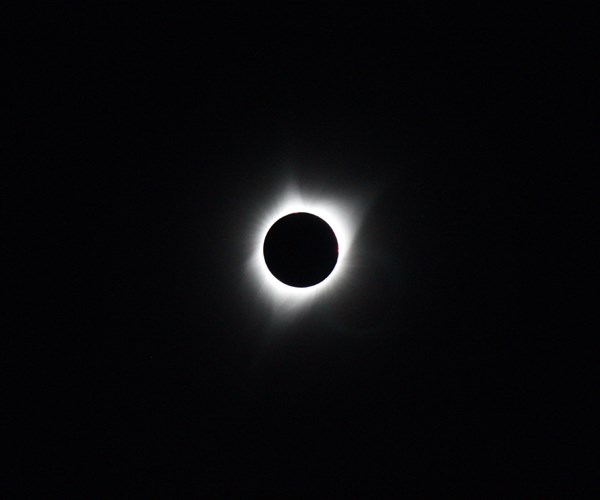A total eclipse of the sun
The humbling, startling, dusky, stunning unreality of a total eclipse of the sun.

August 21 solar eclipse, Imogene Lake, Idaho. (Source: Thomas Sloan)
My oldest son, Thomas, suggested in late July that he was thinking about backpacking into the Sawtooth Wilderness in southern Idaho the weekend before Aug. 21 to bear witness to the totality of a solar eclipse, which was to occur at 11:30 am on that day. He invited a couple of friends to go with him, but they were not available. So, he invited me.
We brought with us Leo, our 1-year-old Golden Retriever, drove 13 hours, arrived at the trailhead on Sunday, Aug. 20 and hiked about 5 miles in to Hell Roaring Lake, where we pitched our tents for the night. The next morning, Aug. 21, at 8:30 am, we hiked another 4 miles to Imogene Lake, and at 10:30 am found a spot along the east side of the lake that offered a great view of the water, mountains and sun, which had, not long before we arrived, cleared the peaks behind us. There were other people there, on the other side of the lake, in small groups, sitting on rocks and outcroppings.
Using our welding glass, we monitored the progress of the moon as it crept slowly in front of the sun, while Leo cooled off in the lake. We were struck, throughout this process, how persistent the sun’s energy and intensity was. Even as the eclipse exceeded 50% totality, there was little discernable difference in the light we could see and feel about us. And it was not until the eclipse reached about 90% totality that we noticed the temperature starting to drop and the color about us in the water, trees and mountains beginning to drain. And then, suddenly, the bees and flies that had found us so interesting all morning, simply vanished. Leo removed himself from the lake and sat next to us on the shore.
Totality struck quickly, as if a veil had been gently draped over the sky, and we were plunged not into total darkness, but a surreal dusk. Jupiter emerged directly overhead. Someone across the lake bellowed in approval. We put down the welding glass and, for the first time, looked at the eclipse with naked eyes. The moon was a solid black disk surrounded by solar prominences protruding in white, gauzy filaments. For 2 minutes it persisted and we consumed, as much as we could, the world around us.
A total eclipse is visually stunning for all of the obvious reasons: The sun is almost perfectly blotted out, day becomes dusk, planets snap into view, the whole world feels closer and smaller. But a total eclipse is remarkable for another reason as well: It offers a complete and thorough disruption of the light cycle rhythm that marks our daily existence. It inserts night when we know it is day. It alters a force of nature that is unalterable. It quietly and gradually suspends our daily reality with with unreality. The world paused, and we paused with it.
And then, just as quickly, it was over. Bright yellow light reanimated itself. Color re-saturated trees, rocks, water. Bees and flies returned, regrettably. Leo jumped back in the water. Thomas and I sat for another 45 minutes and absorbed this gradual restarting of the world and talked about all that we’d seen and felt. Then, we packed up, coaxed Leo of out the water and began our trek back down the mountain.
The next total eclipse in the US is in 2024. Perhaps I will see you there.

Leo, post-eclipse.
Related Content
The next-generation single-aisle: Implications for the composites industry
While the world continues to wait for new single-aisle program announcements from Airbus and Boeing, it’s clear composites will play a role in their fabrication. But in what ways, and what capacity?
Read MoreThe potential for thermoplastic composite nacelles
Collins Aerospace draws on global team, decades of experience to demonstrate large, curved AFP and welded structures for the next generation of aircraft.
Read MoreCombining multifunctional thermoplastic composites, additive manufacturing for next-gen airframe structures
The DOMMINIO project combines AFP with 3D printed gyroid cores, embedded SHM sensors and smart materials for induction-driven disassembly of parts at end of life.
Read More“Structured air” TPS safeguards composite structures
Powered by an 85% air/15% pure polyimide aerogel, Blueshift’s novel material system protects structures during transient thermal events from -200°C to beyond 2400°C for rockets, battery boxes and more.
Read MoreRead Next
Scaling up, optimizing the flax fiber composite camper
Greenlander’s Sherpa RV cab, which is largely constructed from flax fiber/bio-epoxy sandwich panels, nears commercial production readiness and next-generation scale-up.
Read MoreNext-gen fan blades: Hybrid twin RTM, printed sensors, laser shock disassembly
MORPHO project demonstrates blade with 20% faster RTM cure cycle, uses AI-based monitoring for improved maintenance/life cycle management and proves laser shock disassembly for recycling.
Read MoreCutting 100 pounds, certification time for the X-59 nose cone
Swift Engineering used HyperX software to remove 100 pounds from 38-foot graphite/epoxy cored nose cone for X-59 supersonic aircraft.
Read More












